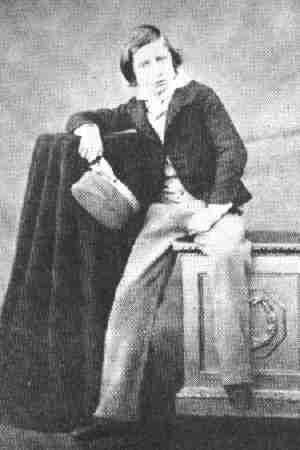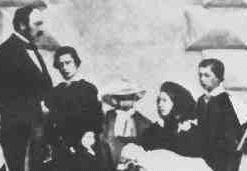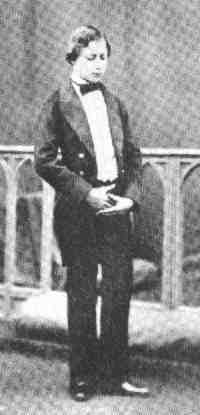
Figure 1.--Detail of a 1849 photograph showing a still boyish suit with a short jacket worn by Edward. Notice the boyish cap.


Figure 1.--Detail of a 1849 photograph showing a still boyish suit with a short jacket worn by Edward. Notice the boyish cap. |
I'm not sure when Edward and his brother were first allowed to
wear more adult-looking clothes. Images taken in 1855 shows the Prince of Wales and his brother beginning to wear adult looking suits. Edward was avout 14 years old, and Alfred was only about 11. About a year or two latter when Edward was 15, he began to wear
long adult-looking frock coats. In another mid-1850s photographs, the boys are not wearing grown-up looking long frock coats. Instead they wear white collars larger than their fathers--looking somewhat
like the tight-fitting Eton collars that English boys were beginning to wear. I'm not sure how widely
Eton collars were worn by English
boys in the 1850s. The style by the 1870s, however, had become commonly worn by older English boys as well as affluebt boys in France, other European countries, and America
The Queen and Prince Albert provided detailed advise to Edward on his dress. His Grandson, the Duke of Winsor (Edward VII), complains in his book Family Albumn of the relative independence his Grandfather had at rather early age. I'm not sure why Victorian was writing to her son at age 10, presumably he was apart from the family for some reason. I'm not sure why.
There survives a letter written in 1851 by Queen Victoria to her eldest son, the Prince of Wales, my grandfather-to-be but then a boy of 10 years old. It appears from this letter drafted, J rather suspect, by the Prince Consort, but underlined, in characteristic fashion, by the Queen that my grandfather, at this early age, already enjoyed financial independence, a degree of emancipation which I myself was not to achieve until the more advanced age of fifteen, following his death, my father's Accession to the Throne, and my own succession to the revenues of the Duchy of Cornwall. It was then his own responsibility to order his meals 'in accordance with what the physicians say is good for you'. From now onwards he was to order his own clothes as well.
`Dress,' his mother writes to him, 'is a trifling matter which might not be raised to too much importance in our own eyes. But it gives also the one outward sign from which people in general can and often do judge upon the inward state of mind and feeling of a person; for this they all see, while the other they cannot see. On that account it is of some importance particularly in persons of high rank. I must now say that we do not wish to control your own tastes and fancies which, on the contrary, we wish you to indulge and develop, but we do expect that you will never wear anything extravagant or slangy not because we don't like it but because it would prove a want of self-respect and be an offence against decency, leading, as it has often done before in others, to an indifference to what is morally wrong.'

Figure 2.--Detail of a 1857 photograph showing the suits sported by Edward and his younger brother Alfred. |
Edward's grandson interpreted this injunction as meaning the clothes make the prince and wondered if this didn't help make his grandfather one of the world's best dressed men.
Prince Albert provided further instructions on clothes in a paper of instruction "for the guidance of gentlemen appointed to attend on the Prince of Wales." It refers to the qualities which distinguish a
gentleman in society, with especial regard to his
manners and costume:
The appearance, deportment and dress of a gentleman consist perhaps more in the absence of certain offences against good taste, and in careful avoidance of vulgarities and exaggerations of any kind, however generally they may be the fashion of the day, than in the adherence to any rules which can be exactly
laid down. A gentleman does not indulge in careless, self-indulgent, lounging ways, such as lolling in armchairs, or on sofas, slouching in his gait, or placing himself in unbecoming attitudes, with his hands in his pockets, or in any position in which he appears to consult more the idle ease of the moment than the maintenance of the decorum which is characteristic of a polished gentleman. In dress, with scrupulous attention to neatness and good taste, he will never give in to the unfortunately loose and slang style which predominates at the present day. He will borrow nothing from the fashions of the groom or the gamekeeper, and whilst avoiding the frivolity and foolish vanity of dandyism, will take care that his clothes are of the best quality, well-made, and suitable to his rank and position. . . .

Figure 3.--The Prince of Wales at the age of 15 about 1856 was wearing quite adult looking.
To all these particulars the Prince of Wales must necessarily pay more attention than anyone else. His deportment will be more watched, his dress more criticized. There are many habits and practices and much in dress which might be quite natural and unobjectionable for these gentlemen at their own homes and in their ordinary life, which would form dangerous examples for the Prince of Wales to copy, and Her Majesty and His Royal Highness would wish them in all their habits to have regard to these consequences, and without any formality or stiffness of manner, to remember both in deportment and in dress that they are in attendance on the eldest son of the Queen.
The Duke of Windsor adds, "Beau Brummell himself,
a man otherwise unlikely to have found much in common
with my great-grandfather, could hardly have expressed
his own philosophy of clothes more aptly—though he
might well have expressed it more wittily.
The Duke added, "Was it not he that laid down, for the gentlemen of his time, the principle of simplicity and restraint in costume ? `If John Bull turns to look after you' he remarked, 'you are not well-dressed but either too stiff, too tight or too fashionable.*
Sir Max Beerbohm has written of him: "Is it not to his
fine scorn of accessories that we may trace the first aim of modern dandyism, the production of the supreme effect through means the least extravagant?' This was a
principle in direct contradiction to the more flamboyant
male fashions of earlier generations.
Navigate the Boys' Historical Clothing Web Site royal pages:
[Return to the main Main Edward VII page]
[Return to the main Main English royalty page]
[Belgium]
[Bulgaria]
[France]
[Germany]
[Italy]
[Japan]
[Jordon]
[Luxemburg]
[Monaco]
[Monaco]
[Netherlands]
[Norway]
[Romania]
[Russia]
[Spain]
[United Kingdom]
[Yugoslavia]
